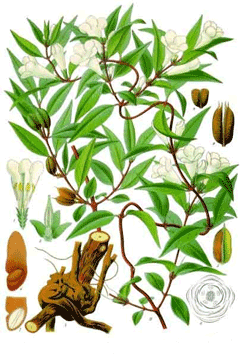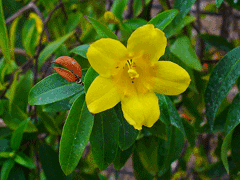 |
|
http://commons.wikimedia.org/wiki/File:Koeh-065.jpg |
 |
| http://commons.wikimedia.org/wiki/User:Llez |
Translate this page:
Summary
Bloom Color: Yellow. Main Bloom Time: Early summer, Early spring, Late summer, Late spring, Mid summer, Mid spring. Form: Prostrate, Variable height, Variable spread.
Physical Characteristics

 Gelsemium sempervirens is an evergreen Climber growing to 3 m (9ft 10in) at a fast rate.
Gelsemium sempervirens is an evergreen Climber growing to 3 m (9ft 10in) at a fast rate.
See above for USDA hardiness. It is hardy to UK zone 9. It is in leaf all year, in flower from May to July. The species is hermaphrodite (has both male and female organs) and is pollinated by Insects.
Suitable for: light (sandy), medium (loamy) and heavy (clay) soils and prefers well-drained soil. Suitable pH: mildly acid, neutral and basic (mildly alkaline) soils. It can grow in semi-shade (light woodland) or no shade. It prefers moist soil.
UK Hardiness Map
US Hardiness Map
Synonyms
G. nitidum.
Plant Habitats
Woodland Garden Sunny Edge; Dappled Shade; South Wall. By. West Wall. By.
Edible Uses
References More on Edible Uses
Medicinal Uses
Plants For A Future can not take any responsibility for any adverse effects from the use of plants. Always seek advice from a professional before using a plant medicinally.
Analgesic Antispasmodic Diaphoretic Febrifuge Homeopathy Hypnotic Mydriatic Nervine
Sedative Vasodilator
The roots are analgesic, antispasmodic, diaphoretic, febrifuge, hypnotic, mydriatic, nervine, sedative and vasodilator[46, 165, 192, 222, 238]. A powerful depressant of the central nervous system, deadening pain and reducing spasms[222]. It is said to suspend and hold in check muscular irritability and nervous excitement with more force and power than any known remedy. Whilst it relaxes the muscles, it also relieves all sense of pain[4]. It is used internally in the treatment of neuralgia, migraine, sciatica, toothache, severe pain (especially in terminal illnesses or accidents) and meningitis[238]. Externally it has been used as a folk remedy for cancer[222]. The root is best harvested in the autumn and dried carefully for later use[4]. Extreme care is advised with the use of this plant, it should only be used under the supervision of a qualified practitioner[238]. Excessive doses cause respiratory depression, giddiness, double vision and death[238]. It should not be prescribed for patients with heart disease, hypotension or myasthenia gravis[238]. See also the notes above on toxicity. The fresh root is used to make a homeopathic remedy[232]. It is used in the treatment of a variety of complaints, including fevers, flu and headaches[232].
References More on Medicinal Uses
The Bookshop: Edible Plant Books
Our Latest books on Perennial Plants For Food Forests and Permaculture Gardens in paperback or digital formats.

Edible Tropical Plants
Food Forest Plants for Hotter Conditions: 250+ Plants For Tropical Food Forests & Permaculture Gardens.
More

Edible Temperate Plants
Plants for Your Food Forest: 500 Plants for Temperate Food Forests & Permaculture Gardens.
More

More Books
PFAF have eight books available in paperback and digital formats. Browse the shop for more information.
Shop Now
Other Uses
References More on Other Uses
Cultivation details
Landscape Uses:Arbor, Container, Woodland garden. Succeeds in most soils[182]. Requires a warm sheltered position in full sun or light shade in a well-drained moisture retentive moderately fertile soil[200]. Rich soils discourage flowering by encouraging excessive growth[200]. This species is not very hardy in Britain, succeeding outdoors only in the mildest areas of the country and even then usually requiring the protection of a wall[166, 182]. Plants can tolerate temperatures down to about -10°c if the wood has been thoroughly ripened[200]. A very ornamental plant, the flowers are sweetly fragrant[222] emitting a honey-like aroma[245]. This species is the state flower of South Carolina[238]. A climbing plant, supporting itself by twining around other plants and often ascending to the tops of lofty trees in its native habitat[4]. Special Features:Attracts birds, North American native, All or parts of this plant are poisonous, Wetlands plant, Extended bloom season in Zones 9A and above, Fragrant flowers, Attractive flowers or blooms.
References Carbon Farming Information and Carbon Sequestration Information
Temperature Converter
Type a value in the Celsius field to convert the value to Fahrenheit:
Fahrenheit:
The PFAF Bookshop
Plants For A Future have a number of books available in paperback and digital form. Book titles include Edible Plants, Edible Perennials, Edible Trees,Edible Shrubs, Woodland Gardening, and Temperate Food Forest Plants. Our new book is Food Forest Plants For Hotter Conditions (Tropical and Sub-Tropical).
Shop Now
Plant Propagation
Seed - sow spring in a warm greenhouse[200]. Prick out the seedlings into individual pots when they are large enough to handle and grow on in the greenhouse until plants are at least two years old. Plant them out into their permanent positions in early summer and give them some protection from winter cold for at least their next winter. Cuttings of half-ripe wood, July/August in a frame[200].
Other Names
If available other names are mentioned here
Native Range
NORTHERN AMERICA: United States (Alabama, Arkansas, Florida, Louisiana, Mississippi, North Carolina, Tennessee, Virginia, Texas), Mexico (San Luis Potosí, Sinaloa, Sonora, Tamaulipas, Chiapas, Guerrero, Hidalgo, Jalisco, Michoacán de Ocampo, Nayarit, Oaxaca, Puebla, Querétaro, Tabasco, Veracruz de Ignacio de la Llave) SOUTHERN AMERICA: Guatemala, Honduras
Weed Potential
Right plant wrong place. We are currently updating this section.
Please note that a plant may be invasive in one area but may not in your area so it's worth checking.
Conservation Status
IUCN Red List of Threatened Plants Status :

Growth: S = slow M = medium F = fast. Soil: L = light (sandy) M = medium H = heavy (clay). pH: A = acid N = neutral B = basic (alkaline). Shade: F = full shade S = semi-shade N = no shade. Moisture: D = dry M = Moist We = wet Wa = water.
Now available:
Food Forest Plants for Mediterranean Conditions
350+ Perennial Plants For Mediterranean and Drier Food Forests and Permaculture Gardens.
[Paperback and eBook]
This is the third in Plants For A Future's series of plant guides for food forests tailored to
specific climate zones. Following volumes on temperate and tropical ecosystems, this book focuses
on species suited to Mediterranean conditions—regions with hot, dry summers and cool, wet winters,
often facing the added challenge of climate change.
Read More
Expert comment
Author
(L.)J.St.Hil.
Botanical References
43200274
Links / References
For a list of references used on this page please go here
Readers comment
| Add a comment |
|
If you have important information about this plant that may help other users please add a comment or link below. Only comments or links that are felt to be directly relevant to a plant will be included. If you think a comment/link or information contained on this page is inaccurate or misleading we would welcome your feedback at [email protected]. If you have questions about a plant please use the Forum on this website as we do not have the resources to answer questions ourselves.
* Please note: the comments by website users are not necessarily those held by PFAF and may give misleading or inaccurate information.
To leave a comment please Register or login here All comments need to be approved so will not appear immediately.
|
Subject : Gelsemium sempervirens
|
|
|
|